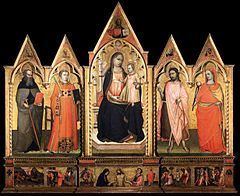Name Lorenzo Niccolo | ||
 | ||
Lorenzo di Niccolò or Lorenzo di Niccolò di Martino was an Italian painter active in Florence from 1391 to 1412. The exact year of Lorenzo’s birth is unknown, but should be approximately 1374, for the first recorded date of his existence is in 1392 when Lorenzo and his mentor, Niccolò di Pietro Gerini, were documented painted frescoes in San Francesco at Pisa.
Contents
Early Life
Lorenzo is often erroneously cited as the son of Niccolò di Pietro Gerini, since he completed some works with the painter. It is more likely that Lorenzo was trained in Gerini’s workshop; therefore, many of Lorenzo’s early works share similarities with the work of Gerini. Lorenzo’s education was limited, as it is thought that he trained under Gerini in a bottega and in a way that was not conducive to learning the highest levels of painting. Gerini’s work focused more on managing many artists on large projects than on working as a skilled painter. Spinello Aretino and Lorenzo's friendships influenced Lorenzo’s own work, as Lorenzo drew inspiration from Spinello’s large-scale frescos and the freedom of imagination in his works. Based on lists of names, Lorenzo was a most likely a member of the Medici e Speziali guild around 1408, and was certainly in the Compagnia di San Luca in 1410. The first surviving work that can be attributed to Lorenzo is a triptych of St Bartholomew Enthroned, with Scenes from his Life. In January 1402 Lorenzo was commissioned to paint the Coronation of the Virgin, a polyptych for Saint Marco in Florence.

Lorenzo's style transformed from one reminiscent of Giotto, to a more elegant and linear style, similar to that of such artists as Lorenzo Monaco. Together with Niccolò di Pietro Gerini, he painted some frescoes in the Chapterhouse of the convent of San Francesco (Prato) and the panel Coronation of the Virgin, once in Santa Felicita. Lorenzo also painted another work on the same subject for the Medici Chapel in Santa Croce, Florence. The work can be dated to 1409 in the predella and today is split between its original location and the Bagatti Valsecchi Museum in Milan.
Lorenzo's painting of the Madonna and Child Enthroned with Sts. Christopher, Blaise, Sebastian, and Francis (c. 1410-1412) is exhibited in the St Louis Museum of Art. Two salvers at the Metropolitan Museum of Art were attributed to the Studio of Lorenzo di Niccolò by the art historians Elizabeth Gardner and Federico Zeri. It has been proposed that the subject of these salvers is a story from Boccaccio's Comedia delle Ninfe Fiorentine.
Maturity
Throughout his career, Lorenzo maintained Trecento traditions in his work, a style that he learned from Gerini. Lorenzo’s works, such as Saint Giovanni and his enemy before the crucifix in Saint Miniato, serve as defining models of Florentine art’s transitional period at the beginning of the 15th century. Saint Giovanni and his enemy before the crucifix in Saint Miniato is just one example of Lorenzo’s work that connects the artist to the Florentine art circle that continued to work in a form of late Gothic style in the 15th century. This circle was centered around Lorenzo Monaco. Many of Lorenzo’s works focus on decorative pattern and do not seem to be concerned with the naturalistic intentions of Renaissance artists working in 15th century Florence.
Lorenzo had a son, Piero, who was trained in painting at the Arte dei Medici e Speziali in 1422 and became a painter in his own right. At this time, Lorenzo had already died. The last dated work that is attributed to Lorenzo is Virgin and Child with Saints, a polyptych in Saint Lorenzo a Collina at Mezzomonte from 1412.
Market
Seven auction results between January 1998 and October 2016 are public record through ArtNet. These works, mostly consisting of tempera on panel, generally have sold far beyond their estimated prices. Lorenzo’s works ultimately have sold between $40,250 and $870,596 based on these public records.
